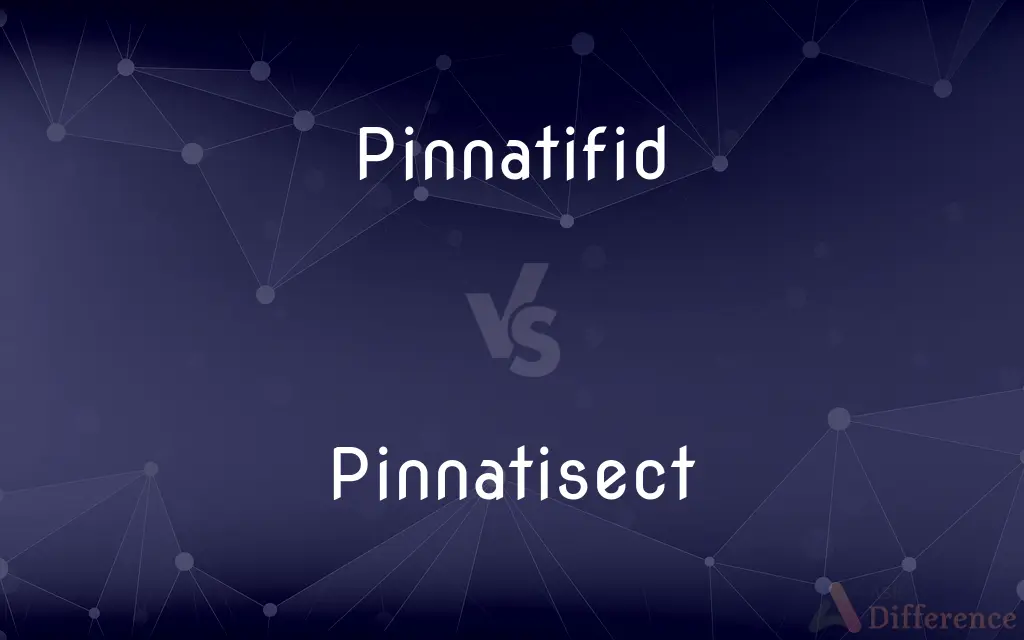Pinnatifid vs. Pinnatisect — What's the Difference?
Edited by Tayyaba Rehman — By Fiza Rafique — Published on October 13, 2023
Both describe leaf divisions; pinnatifid leaves have lobes cut halfway to the midrib, while pinnatisect leaves have divisions reaching the midrib but not separating.

Difference Between Pinnatifid and Pinnatisect
Table of Contents
ADVERTISEMENT
Key Differences
Pinnatifid and pinnatisect both refer to the morphology of divided leaves. While pinnatifid indicates a leaf whose lobes or segments are cut about halfway towards the central midrib, pinnatisect means the divisions reach the midrib but don't fully separate the segments.
The appearance of pinnatifid leaves can be likened to a feather, with the leaf segments not fully reaching the midrib, giving a slightly "incomplete" cut appearance. Pinnatisect leaves, however, give the appearance of almost completely divided segments, touching the midrib but still connected.
When studying plant morphology, these terms can help botanists identify and classify plants based on their leaf structure. Pinnatifid, with its partial divisions, and pinnatisect, with its nearly complete divisions, are distinctive features that can aid in species identification.
It's important to note that the terms pinnatifid and pinnatisect are specific to pinnately divided leaves. While both imply a form of division, the degree and nature of that division differ between the two, offering a more nuanced understanding of the leaf's structure.
Comparison Chart
Definition
Leaves with lobes cut about halfway to the midrib
Leaves with divisions reaching the midrib but not separating
ADVERTISEMENT
Appearance
Feather-like with "incomplete" cuts
Almost completely divided segments
Relation to midrib
Segments don't reach the midrib
Divisions touch the midrib but remain connected
Use in classification
Helps identify species with partially divided leaves
Helps identify species with nearly separated leaf segments
Common in illustrations
Depicted with lobes or deep sinuses, not reaching the midrib
Depicted with almost separated segments, a tiny connection remains
Compare with Definitions
Pinnatifid
Leaf morphology where divisions don't touch the midrib.
In some fern species, you can observe the pinnatifid structure of the leaves.
Pinnatisect
Describing leaves nearly divided into separate segments.
Pinnatisect leaves give the plant a distinct, segmented appearance.
Pinnatifid
Leaves divided halfway towards the central midrib.
The oak leaf is often pinnatifid, with deep lobes not reaching the center.
Pinnatisect
Leaf morphology where divisions touch the central midrib.
Among the variety, the plant with pinnatisect leaves was the most interesting.
Pinnatifid
Characterized by deep but incomplete cuts in leaf segments.
The pinnatifid nature of the leaf segments made it stand out among other species.
Pinnatisect
Characterized by nearly separated leaf segments.
The plant's pinnatisect leaves almost looked like separate entities.
Pinnatifid
Describing leaves with feather-like divisions.
The plant's pinnatifid leaves gave it a delicate appearance.
Pinnatisect
Botanical term for almost fully divided leaves.
The specimen was identified as having pinnatisect divisions, unique among its kind.
Pinnatifid
Botanical term indicating partial leaf division.
Botanists identified the specimen by its pinnatifid leaf structure.
Pinnatisect
Leaves with divisions almost reaching separation, touching the midrib.
The dandelion has pinnatisect leaves that are deeply lobed.
Pinnatifid
Pinnately divided or cleft
A pinnatifid leaf.
Pinnatisect
Having lobes with incisions that extend almost, or up to midrib.
Pinnatifid
Having lobes with incisions that extend less than half-way toward the midrib.
Pinnatisect
Of a leaf shape; cleft nearly to the midrib in narrow divisions not separated into distinct leaflets
Pinnatifid
Divided in a pinnate manner, with the divisions not reaching to the midrib.
Pinnatifid
Of a leaf shape; cleft nearly to the midrib in broad divisions not separated into distinct leaflets
Common Curiosities
How are pinnatisect leaves different from pinnatifid?
Pinnatisect leaves have divisions that touch the midrib but don't fully separate the segments.
Do pinnatifid leaves have complete divisions?
No, pinnatifid leaves have lobes or segments cut about halfway to the midrib.
Are pinnatifid and pinnatisect terms used in botany?
Yes, both terms describe types of leaf divisions in plants.
Can these terms help in plant classification?
Yes, they assist botanists in identifying and classifying plants based on leaf structure.
Do all plants have either pinnatifid or pinnatisect leaves?
No, these are specific types of leaf divisions, and many plants have different leaf morphologies.
Is the pinnatisect leaf division common in dandelions?
Yes, dandelions often have deeply lobed, pinnatisect leaves.
Are pinnatifid leaves feather-like in appearance?
Yes, pinnatifid leaves can resemble feathers due to their partial divisions.
Share Your Discovery

Previous Comparison
WOW vs. Warcraft
Next Comparison
Collaborator vs. TeammateAuthor Spotlight
Written by
Fiza RafiqueFiza Rafique is a skilled content writer at AskDifference.com, where she meticulously refines and enhances written pieces. Drawing from her vast editorial expertise, Fiza ensures clarity, accuracy, and precision in every article. Passionate about language, she continually seeks to elevate the quality of content for readers worldwide.
Edited by
Tayyaba RehmanTayyaba Rehman is a distinguished writer, currently serving as a primary contributor to askdifference.com. As a researcher in semantics and etymology, Tayyaba's passion for the complexity of languages and their distinctions has found a perfect home on the platform. Tayyaba delves into the intricacies of language, distinguishing between commonly confused words and phrases, thereby providing clarity for readers worldwide.
















































